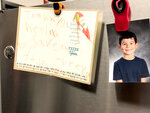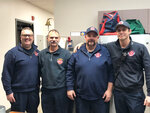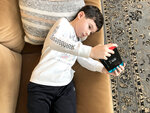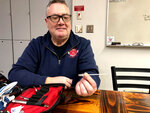




Greyson Reichelderfer of Palmer Lake, 7, just wanted to play one more video game before going to bed Dec. 6. He wound up in ICU at Mary Bridge Hospital fighting for his life, a fight he won because of his dad, Paul, and the quick thinking of Key Peninsula firefighters.
“It was about 8:30,” Paul said. “I was in the back of the house, and he came in. He was very excited because he’d just won firstplace at Fortnight. I took a picture of him, and he said could I play one more round before bed and literally within a minute he was screaming ‘Dad!’ ”
Paul ran into the living room. Greyson was on his left side, near a large metallic coffee table. Through tears he said he’d been lying on the couch, kind of moving around and holding the game controller over his head with both hands. He slid off and his neck hit the table leg or corner because he didn’t want to let go of the controller.
“I was lying down like this,” Greyson said, recreating the accident. “I thought I was going to fall down right here where you could actually break your neck.”
Paul said, “The only thing that I saw was a hairline scratch, like a cat scratch, just enough to make a white line,” at the base of his neck.
“I didn’t really see anything wrong, but I could tell in his voice, and I could see fear in him. Something was obviously very wrong.”
He carried his son next door to where his ex-partner lives and told her to call 911.
B Shift was on that night. A KPFD medic unit was dispatched from the Longbranch station, and a fire engine came from Home. It’s standard practice to send two units to medical calls, according to Public Information Officer Anne Nesbit.
“Our medic units are a team of two,” she said. “An engine responds on every call for EMS support since there are some calls that require more than two people to assist and you don’t want to stand around and wait for them to get there.”
This was that kind of call.
Lt. Paul Pavolka, a firefighter/paramedic with 16 years at KPFD, was the lead medic in the ambulance with FF/EMT Tim Davis, a 20-year veteran, and the driver.
“The first thing that went through my head was, ‘Oh, kid fell, hurt shoulder. Kids are like rubber, they cry and bounce back,’ ” Pavolka said. “We thought we’d probably just put him in a sling and mom and dad can take him to the hospital. Routine call.”
The engine beat them to the scene, staffed by FF/EMT Andrew Pittman, who has one year with KPFD but six in the fire service; Brady Blue, FF/EMT, a former local volunteer now on the job for two years; and FF/ EMT Keith Brogan with three years.
“We show up, the kid’s crying on the floor, acting appropriately, so, good,” Davis said. “The engine crew was already there, working on the kid, getting information, trying to figure out the whole story. So Paul and I are just kind of standing there letting those guys do their thing. But some of the guys that we have are pretty new, so I jumped in to give my two cents, look the kid over. Dislocated shoulder maybe? But it was weird that he was laying on the side that was injured.”
Pavolka said, “The EMTs are your eyes, your ears and your hands,” allowing the paramedic to stand back and take in the whole scene, supervise, and make a plan. His was to transport Greyson to Mary Bridge Hospital in Tacoma because this was more serious than he expected. It was a big decision because it would mean taking a medic unit off the Key Peninsula for a minimum of 90 minutes, but Mary Bridge is the best choice for treating children.
“We got him packed up, put him in the rig, start hooking up to the monitors,” Davis said. “And he was still crying, acting appropriately; dad came inside the ambulance trying to console his son. Paul got on the phone with Mary Bridge.” Pavolka was talking to an ER nurse about dosage for a sedative, routine practice with a child patient.
“I was talking with dad and the kid sat up and turned blue, just like that,” Davis said.
“I said, ‘Paul, he’s not breathing,’ lay him down, try to open his airway, but he’s fighting. I think that’s when Keith grabbed the I-gel (emergency airway) and I said, 'We gotta go.' ” Davis kept Pittman, told Blue to take charge of the engine, pulled dad into the passenger seat, and started driving.
“This hadn’t been very long, six or seven minutes since we got on the scene,” Pavolka said. “His face was swelling, his eyes were swollen, his neck — he looked like a bodybuilder in his chest, all the way down to his knees, right in front of me, he was just getting bigger.”
As he moved to the passenger seat, his dad saw it all happen.
“It was like the kid in Willy Wonka, I didn’t know that could happen to a person,” Paul said. “It was so strange, I felt like I was blacking out. The guy driving calmed me down.”
Pavolka thought it might be an allergic reaction. “I asked his dad numerous times, is he allergic to anything? No, no, no, nothing. But something different was happening right in front of us. His oxygen saturation was going down, his heart rate was going up, his blood pressure was going down. We were going in the wrong direction.
“I yelled at Tim, ‘We need another medic.’ ”
B Shift is commanded by Battalion Chief Bill Sawaya, who’s been with KPFD for 29 years and a BC for 10.
“Sitting here in the station, listening to the call, I’m monitoring time and arrivals and who is where,” Sawaya said. “I hear Tim get on the radio to request Medic 44 (at Wauna) to make a rendezvous. This is very rare, so that told me things were serious. Medic 44 asked where they would meet and the words that I heard were ‘I don’t care, just drive south.’
“I’ve listened to Tim on the radio for 20 years and I have never heard him sound like that. Tim was, Tim was, ...”
“Tim was scared,” (Tim) Davis said.
“We all were,” Pavolka said.
Medic 44 intercepted 49 somewhere near The Red Barn Youth Center in the middle of the KP Highway. FF/PM Jeff Gordon jumped out, crossed the road and jumped into 49.
As soon as the door shut, Pavolka yelled to Davis: “Diesel!”
That’s code for “I don’t care what the ride is like, go,” Pavolka said. “Tim is one of our best if not the best driver we have. He can drive fast without throwing us around in the back, and there were four of us back there plus a patient we’re trying to keep alive.”
Davis said, “These guys are doing their thing and I’m trying to keep dad calm, saying, ‘Hey, he’s in good hands, everything’s going to be good,’ and it’s 9 o’clock at night and it’s dark, and driving on the KP Highway is dangerous at noon, just trying to drive 33 miles to Tacoma, trying to watch for dogs, deer and drunks, and nobody pulls over for you. I had six people’s lives. I had to get there. I’ve done it a million times, but that one was stressful.”
Gordon, who has 15 years in the fire service and two with KPFD, said “I had the advantage of not being there for the emotional side of it at the beginning. So I got in, Andy is across from me doing vitals, Keith is on airway, breathing with the kid on the bag, Paul is telling me the story.”
Pavolka said, “I tell Jeff, ‘It’s gotta be air. I think we’ve got to dart his chest.’ I’ve done tons of chest darts. But I’ve never seen anything like this before, and never done one on a kid.”
“It was subcutaneous emphysema,” Gordon said. “We’ve all seen it but usually it’s smaller; the skin feels like Rice Krispies, like bubble wrap because every time he breathed air was going under the skin and muscles, not into the lungs; that is why he was changing color, there was no air exchange in the lungs.” It’s the kind of thing one would expect only after a major trauma to the chest, like in a car crash.
“I grabbed the kid and started looking for landmarks (for the darts), ribs, clavicle. He was so swollen I couldn’t tell where to go. So I went down the side between his ribs, said, ‘Give me a 14 gauge’ (something like a hollow crochet needle). He was so small. You’re not trying to get into the lungs, you’re trying to get the air out of the space around the lungs to relieve pressure on them. I went right in, got a little bit of air, not very much. Paul got back on the phone with Mary Bridge.”
Pavolka told the ER doctor, “We’re going to have a trauma code before we get to the hospital. His oxygen saturation was down in the 70s, heart rate in the 60s, everything going down, I thought we were a couple minutes from doing CPR.”
The odds of surviving CPR are not good: just 5-10% survive if it’s performed outside a hospital.
“That’s where we’re at,” Pavolka said. “This kid is dying. I could hear the doc on the phone matching my voice, my tone, he could tell. I said get the trauma team ready.”
Then Gordon got a second dart into Greyson’s other side. “More air came out and he started to level out.”
“We were right there when we were going to start chest compressions and we stopped it right there, right at the line,” Pavolka said.
“We didn’t fix him, but he wasn’t getting any worse,” Gordon said.
Paul, Greyson’s dad, said there must have been 50 people waiting for them at Mary Bridge. Gordon said it was difficult to move through the halls. The ER doctors took charge, immediately inserting multiple chest tubes into Greyson, disgorging large bubbles of air and blood. They X-rayed him and put him on a ventilator, knocking out his two top front teeth.
The senior doctor told the KP crew Greyson had a tear in his trachea and a bruised carotid artery from hitting the table. It didn’t take much but was enough to start the chain of events. “We’re going to talk about this later,” the doctor said, “because none of us have ever seen anything like this. You did everything right.”
“When we got back to the unit, we all just sat down in the back,” Pavolka said. “Do you want coffee? Yeah, no, wait, what? We were all kind of shaking.”
“I looked at my watch and couldn’t tell what time it was,” Gordon said.
“I couldn’t drive back,” Davis said.
“My job kicked in when everybody got back to the station,” Sawaya said. “Guys were visibly shaken up by the whole thing and one guy broke down. They’ve all got kids.”
“People die every day but when it comes to children, they haven’t had a life yet, they need more,” Davis said.
Sawaya said, “Statistically with tracheal tears, 80% of patients that have it don’t make it to the ER. The kid had everything going for him though because all of these guys were fully engaged, from placing the airway, to driving, to recognizing the subcue and changing the needle preference. The ER staff need to be recognized too; they were cued up, they had the benefit of getting the heads-up call, but they’re still fully engaged in the moment too.
“I’m pretty proud of everybody on this one.”
Two weeks later, B Shift was working on Christmas Day. The crew’s families spent the day with them at the Home station having an extended dinner between calls, playing pickleball, and watching football.
Greyson and his dad stopped by.
He showed Gordon the scars where the chest tubes were inserted. “That right there is where the actual tube was,” he said. “But that needle you put in hurt.”
He told Brogan, “I remember when you guys came in and you gave me a balloon to breathe in to calm down. And you came to the hospital, and everyone was crying.”
Brogan had visited Greyson and his parents in ICU the day after the accident, while Greyson was in an induced coma. “I gave him a hug, and hugged the parents, and there were some tears. I don’t usually do that, but I needed to process this.”
Brogan later led a refresher course for all KPFD personnel on the use of the I-gel emergency airway based on his experience on the call, since it is relatively new to the service.
Greyson’s dad Paul said, “For those guys to come in and be so reliably proficient and professional, I’m just so thankful for that. They made choices that really mattered.”
“It was about four days of ‘We’re not out of the woods yet,’ but there was nothing that could have gone better,” he said. “Every bit of luck was in his corner. Beating the statistic of making it to the hospital, being at the very end, and making a miraculous recovery, and all the staff. I am so happy my son’s here.”
Greyson missed a few days of school but is back in his second-grade class at Evergreen Elementary. His classmates gave him a bunch of homemade cards that decorated his house, together with his two front teeth, which were displayed on the family Christmas tree.
UNDERWRITTEN BY THE FUND FOR NONPROFIT NEWS (NEWSMATCH) AT THE MIAMI FOUNDATION, THE ANGEL GUILD, ADVERTISERS, DONORS AND PEOPLE WHO SUPPORT INDEPENDENT, NONPROFIT LOCAL NEWS